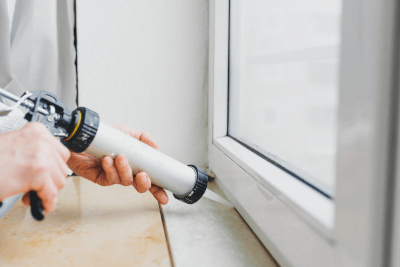What Is a Sealant?

A sealant is a paste material used to fill gaps in buildings to keep them waterproof and airtight.
Sealants are usually stored in tubes or cartridges and are applied by attaching the container to a special gun. Sealants can be either one-component (all components are pre-mixed) or two-component (the two components are mixed together at the time of use).
One-component systems can be moisture cured, dry cured, or non-hardened, while two-component systems are mixed reaction cured. Various polymers such as silicone and polyurethane are used as raw materials.
Uses of Sealants
Sealants are mainly used for repairing, maintaining confidentiality, and remodeling buildings. For example, silicone sealants are used in bathrooms and kitchens, and modified silicone sealants are used on exterior walls.
One way to prevent cracks in siding during remodeling is to fill the joints with a sealant in advance. Sealants are also used to secure printed circuit board components, seal connectors, and insulate electrical appliances.
Principle of Sealants
Sealants are composed of raw material polymers, additives for curing, and additives for adjusting various properties, such as viscosity. Various types of raw polymers are used, such as silicone, modified silicone, polyurethane, and acrylic, depending on the curing mechanism.
The characteristics of sealants vary depending on the raw material polymer. For example, polyurethane-based sealants are characterized by extremely high durability and elasticity after curing. Upon release from the tube, the sealant is a soft paste.
One-component products cure when exposed to moisture in the air (moisture cure type) or when dried (dry cure type), while two-component products cure when the two pastes (base and hardener) are mixed together. There are three stages in the curing process of sealants:
1. Surface Hardening
This is the state in which the sealant does not string when touched by hand. The surface of the sealant has not hardened completely.
2. Membrane Hardening
The surface has completely hardened. At this point, it is possible to paint over the sealant.
3. Complete Hardening
The inside of the sealant has hardened completely, and the strength of the sealant has been obtained.
Types of Sealants
The characteristics and installation methods of typical sealants (silicone, modified silicone, and urethane) are described below. When installing, the curing time must be observed, or the sealant may fail. Curing time differs depending on the type of sealant, so care should be taken.
1. Silicone Type
Most commonly used in general households around water. It has excellent heat and cold resistance and cost performance. The disadvantage is that it cannot be painted over.
After the silicone-based coating is applied, 0.5 mm of the surface hardens in about 1 hour. After about 8 hours, 2 mm of the film is cured, and after about 24 hours, 3 mm of the film is fully cured.
At the film-hardening stage, the caulking can be used around water. In other words, baths and kitchens can be used approximately 8 hours after caulking.
2. Modified Silicone Type
This is a sealant used outdoors. Unlike silicone type, it can be painted on top.
About 2 hours after casting, 0.5 mm of the surface hardens. After about 24 hours, 2 mm of the film is cured, and after about 72 hours, 3 mm of the film is fully cured.
Although it takes time to fully cure, once the surface is cured, there is no need to worry even if it gets wet. Also, it is safe to apply water-based paint after about 1 hour and oil-based paint after about 12 hours.
The reason why there is such a time difference between water-based and oil-based is that when oil-based is used, the silicone-based must cure at least 70%.
3. Urethane Type
Urethane is a sealant used outdoors. It has excellent adhesion and elasticity. Since it is weak against ultraviolet rays, it is used on the assumption that it will be painted when used outdoors.
0.5mm of the surface hardens in about 2 hours after it is cast out. About 3 days later, 2 mm of the film is cured, and about 7 days later, 3 mm of the film is fully cured.
This type requires even longer time than the modified silicone type. However, urethane sealants are used in large-scale construction sites such as mortar exterior walls and concrete caulking.
Other Information on Sealants
How to Store Excess Sealant
Ideally, all sealants should be used up in a single installation. However, there are cases when there is inevitably a surplus. If you have any excess sealant, first cut the tip of the sealant to the size of the installation area.
At this point, it is important to store the excess tip without discarding it. After the installation is finished, turn the stored tip upside down and insert it into the nozzle. At this time, insert the tip firmly to prevent air from entering and sealant from leaking through the gap. Finally, use tape to keep the nozzle in place, being careful of air and gaps.
Sealant hardens when exposed to air. Therefore, it is important to store the sealant properly so that it will not be unusable the next time it is installed.